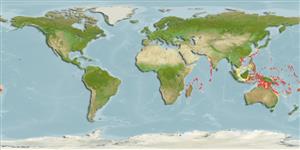Common names from other countries
Environment: milieu / climate zone / depth range / distribution range
Ecologia
marinhas associadas(os) a recifes; intervalo de profundidade 3 - 50 m (Ref. 90102). Tropical
Indo-Pacific: Chagos Archipelago and Maldives; non-types from the Great Barrier Reef, Fiji, New Guinea, and the Philippines.
Tamanho / Peso / Idade
Maturity: Lm ? range ? - ? cm
Max length : 2.1 cm SL macho/indeterminado; (Ref. 9360)
Descrição suscinta
Chaves de identificação | Morfologia | Morfometria
Espinhos dorsais (total) : 6 - 7; Raios dorsais (total) : 8 - 9; Espinhos anais: 1; Raios anais : 8. Characterized by semi-translucent with orange/brown scale margins; three large orange to brown blotches behind pectoral fin; head with large dusky orange spots/bands; pectoral fin base with a pair of large brown to reddish spots on pectoral fin base; small dark spots present on dorsal and caudal fin rays; absence of pelvic frenum; branched caudal rays 12; longitudinal scale series 25-26; ctenoid scales on body except cycloid near midline of abdomen; head, nape, pectoral fin base and breast scaleless; depth of body 5.0-5.5 in SL (Ref. 90102).
Inhabits reef crevices (Ref. 90102).
Ciclo de vida ou comportamento de acasalamento
Maturities | Reprodução | Spawnings | Egg(s) | Fecundities | Larvas
"The entire reproductive sequence consisted of nest preparation by a male, courtship behaviors, nest entry by a female, spawning, and paternal care until the hatching of eggs." The sequence of behavior observed during courtship in the laboratory were as follows: "The male approached a female. The female responded to the male approach with yawning. In leading, the male returned to its nest. Tail-waving was performed during stopping." (Ref. 58424).
Randall, J.E. and M. Goren, 1993. A review of the gobioid fishes of the Maldives. Ichthyol. Bull. J.L.B. Smith Inst. Ichthyol. (58):1-37, 5 pls. (Ref. 9360)
Status na Lista Vermelha da UICN (Ref. 130435)
CITES (Ref. 128078)
Not Evaluated
Ameaça para os humanos
Harmless
Uso pelos humanos
Ferramentas
Relatórios especiais
Baixar XML
Fontes da internet
Estimates based on models
Preferred temperature (Ref.
115969): 26.2 - 28.9, mean 27.6 (based on 282 cells).
Índice de diversidade filogenética (Ref.
82804): PD
50 = 0.5078 [Uniqueness, from 0.5 = low to 2.0 = high].
Bayesian length-weight: a=0.01023 (0.00477 - 0.02194), b=3.02 (2.84 - 3.20), in cm Total Length, based on LWR estimates for this (Sub)family-body shape (Ref.
93245).
Nível Trófico (Ref.
69278): 3.1 ±0.3 se; based on size and trophs of closest relatives
Resiliência (Ref.
120179): Baixo, tempo mínimo de duplicação da população 4,5 - 14 anos (Fec = 34).
Fishing Vulnerability (Ref.
59153): Low vulnerability (10 of 100).
